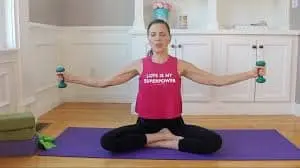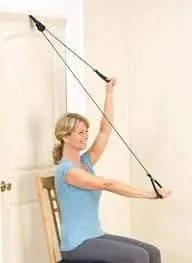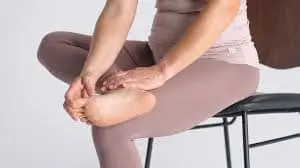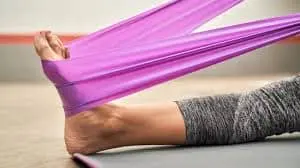11 Best Exercise For Kyphosis
Kyphosis (rounding of the upper back) is often caused by weak posture or muscular imbalances. The best exercises for kyphosis focus on strengthening the back extensors, improving posture, and increasing spinal mobility to help restore proper alignment and reduce discomfort.
Before beginning any workout regimen, always get medical advice, especially if you have spinal pain or abnormalities.
Introduction:
A spinal disorder called kyphosis causes the upper back to curve excessively forward, giving the impression of a rounded or hunched back. Although some kyphosis is typical, particularly in the thoracic spine, too much curvature can be uncomfortable, stiff, and unsightly.
Severe or chronic kyphosis can result in pain, decreased mobility, and even breathing problems, whereas mild examples might not create any significant problems. Fortunately, posture can be greatly improved, symptoms reduced, and progression often avoided with focused Exercise For Kyphosis.
By strengthening weak back muscles, stretching tight shoulder and chest muscles, increasing spinal flexibility and mobility, and developing postural awareness and control, exercise helps people with kyphosis.
Types of kyphosis:
Postural Kyphosis
Long-term poor posture (hunching, slouching).
- Common among young people and teenagers.
- A flexible spine frequently improves its curve when standing upright.
- Usually painless and mild.
Scheuermann’s Kyphosis
A spine structural abnormality that occurs during childhood.
- Rather than being rectangular, the vertebrae are wedge-shaped.
- When posture is corrected, the more rigid curve does not straighten.
- May result in stiffness and back pain.
Degenerative (related to age) The kyphosis
Age-related spinal degradation, such as osteoporosis, disc degeneration, and arthritis.
- The vertebral collapse caused by weakened bones results in a forward curvature.
- More prevalent in senior citizens.
- Can result in pain, rigidity, and a loss of height.
Congenital Kyphosis
Birth-related spinal deformity (genetic or developmental problem).
- The spine’s bones don’t grow correctly during pregnancy.
- Early identification is common.
Neuromuscular Kyphosis
Neuromuscular disorders (muscular dystrophy, cerebral palsy, etc.).
- The spine’s weak muscles are unable to maintain proper posture.
- A worsening of the underlying condition can cause the curve to advance significantly.
Exercise’s advantages:
Improves Posture
- The thoracic area, or upper spine, frequently curves excessively forward due to kyphosis.
- The muscles down your back, known as the posterior chain, are strengthened via exercises, particularly the erector spinae, trapezius, and rhomboids.
- By pulling the shoulders back, these muscles realign the spine to a more neutral and upright position.
Lessons Back Pain
- The spinal cord receives more blood when you exercise.
- Muscle tightness is reduced, inflammatory chemicals are eliminated, and intervertebral discs are nourished.
- By relieving the strain on the joints and vertebrae, stronger muscles lessen degeneration.
Improves Stability and Balance
- The body’s center of gravity is maximized when the spine is positioned correctly.
- Exercises that strengthen the core improve neuromuscular control and a sense of balance, or body awareness.
Improves Mobility and Flexibility
- Kyphosis frequently causes the shoulders, hip flexors, and chest muscles (pectoralis major and minor) to tense.
- By lengthening these muscles, stretching exercises make it easier to extend the spine and retract the shoulders.
Bone Strengthening and Osteoporosis Prevention
- Walking and resistance training are examples of weight-bearing activities that activate osteoblasts, which are cells that create bones.
- In order to avoid spinal compression fractures, a leading cause of kyphosis progression in older persons, this improves bone mineral density.
Prevents Additional Curve Development
- The mechanical forces forcing the spine forward are countered by regular stretching and strengthening.
- Exercises create flexible spinal stability even when you’re moving.
Improves the Respiratory System
- Excessive kyphosis can limit diaphragm mobility, compress the rib cage, and reduce lung expansion.
- Better breathing space in the thoracic cavity is restored by exercises that increase spinal extension and open the chest.
Makes Supporting Muscles Stronger
- Stabilizing the spine and maintaining an upright posture is made possible by the hip, back, and core muscles.
- Stress on the vertebrae and spinal discs is lessened by an effective support structure.
Increases Confidence and Mental Wellbeing
- Standing upright and tall alters the chemistry of the brain; posture may improve mood, improve self-esteem, and lessen the symptoms of depression.
- Exercise increases the creation of endorphins, which are naturally occurring “feel-good” compounds.
Exercise For Kyphosis:
Chin Tucks
For kyphosis (the rounding of the upper back and forward head posture), chin tucks are an excellent workout. They encourage improved head and spine posture and strengthen the deep neck flexors.
- Stand or sit up straight.
- Maintain a comfortable posture.
- Look directly forward.
- Pull your chin straight back with gentle pressure, creating a “double chin.”
- Consider attempting to position your ears over your shoulders.
- Don’t tilt your head up or down; instead, move it straight back.
- Hold this position for a few seconds.
- In the front of your neck, you should feel some muscular activation and a tiny stretch at the base of your skull.
- Then return to your neutral position.
- Then relax.
- Repeat these exercises 5 to 10 times.
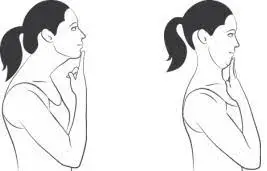
Band Pull-Aparts
For kyphosis, Band Pull-Aparts are great!
They help in strengthening the rhomboids, mid traps, and rear deltoids, which are among the upper back muscles that are frequently weak in people with rounded upper backs.
- Either sit or stand up straight.
- Hold a resistance band, such as a therapeutic band or a loop with light to medium strength.
- With your hands shoulder-width apart and your arms straight out in front of you at chest height, grasp the band.
- You can either face your palms down or face each other; small variations focus on slightly different muscles.
- Straighten your arms out to the sides and pull the band apart.
- Squeeze your shoulder blades together with concentration.
- Don’t bend your elbows too much; instead, keep them straight or slightly bent.
- Hold this position for a few seconds.
- When the band comes into contact with your chest or you experience a sharp contraction between your shoulder blades, stop.
- Then return to your neutral position.
- Then relax.
- Repeat these exercises 5 to 10 times.

Cat-Cow Stretch
It helps you regain healthy spinal motion, increase flexibility, and gently mobilize the spine especially if your upper back feels rigid.
- On your hands and knees, get down.
- Gently press your fingers into the floor after spreading them wide.
- Take a deep breath.
- Your back can be bent by raising your tailbone and chest toward the ceiling.
- Allow your stomach to fall toward the ground.
- Without straining your neck, slowly raise your head so that it looks slightly upward.
- Hold this position for a few seconds.
- Take a deep breath out.
- With your spine rounded toward the ceiling, tuck your pelvis beneath.
- Raise your belly button in the direction of your spine.
- Gently tuck your chin into your chest.
- Hold this position for a few seconds.
- Move fluidly from cow to cat.
- Breathe in for Cow and out for Cat as you move slowly and in time with your breathing.
- Then return to your neutral position.
- Then relax.
- Repeat these exercises 5 to 10 times.
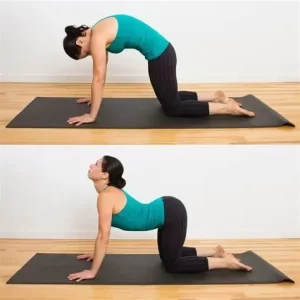
Bird-Dog Exercise
It works the muscles that you need to develop to correct posture and keep your spine tall and straight: your core, lower back, and mid-back stabilizers.
- Start with kneeling position.
- Maintain a neutral spine one that is flat and neither drooping nor too arched.
- Try to slightly engage your core.
- Straighten out your right arm in front of you.
- In parallel, straighten your left leg behind you.
- Stretch your reach while maintaining a straight line between your fingers and toes.
- Don’t allow one hip to tilt upward; instead, keep them parallel to the floor.
- Hold this position for a few seconds.
- Return to your starting posture by lowering your arm and leg gradually.
- Then return to your neutral position.
- Then relax.
- Repeat these exercises 5 to 10 times.
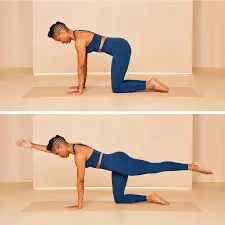
Knee to chest
Stretching the hips and lower back is the primary goal of the easy yet effective Knee-to-Chest Stretch.
- Place yourself on your back on the ground.
- Pull one leg slowly up to your chest while bending it.
- Your hand should remain on your shin or the back of your leg.
- The foot should be grounded on the floor while the opposing leg remains straight.
- Pull the knee toward your chest gently.
- Hold this position for a few secoonds.
- Lower the leg slowly after releasing it.
- Then return to your neutral position.
- Then relax.
- Repeat these exercises 5 to 10 times.
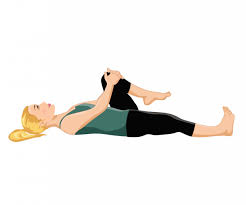
Scapular Squeezes
An effective exercise for kyphosis is the scapular squeeze! By focusing on the rhomboids and traps of the upper back, they improve the capacity to draw the shoulders back.
- Standing in an upright position.
- Put your arms by your sides and bend your elbows to a 90-degree angle.
- The shoulder blades should be squeezed together as though you were trying to squeeze a pencil between them.
- Don’t overarch your back when you squeeze; instead, allow your elbows to naturally go backward.
- Hold this position for a few seconds.
- Then return to your neutral position.
- Then relax.
- Repeat these exercises 5 to 10 times.
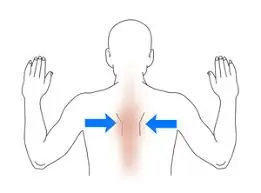
Pelvic tilts
As pelvic tilts serve to improve the alignment of your lower back, pelvis, and ultimately your spine, they are an excellent exercise for kyphosis.
- On the floor, resting flat on your back.
- Keeping your feet flat on the ground.
- Next bend both knees.
- The pelvis should be pulled in by gently moving the belly button closer to the spine.
- Squeeze your glutes (buttocks) while performing the pelvic tilt to engage your core and lower back muscles.
- Hold this position for a few seconds.
- Then return to your neutral position.
- Then relax.
- Repeat these exercises 5 to 10 times.
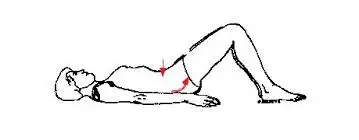
Superman
Since the Superman Exercise focuses on strengthening the muscles that are essential for better posture and spine in the lower back, glutes, and upper back it’s a great option for treating kyphosis.
- Lay face down on a level surface, like a mat.
- Stretch your arms straight out in front of you, palms down, as if you were flying through the air.
- Ensure that your toes point downward and that your legs are straight behind you.
- Using your lower back, glutes, and upper back muscles, raise your arms, chest, and legs off the ground together.
- Avoid putting excessive pressure on your neck or lower back by keeping your arms and legs as long and raised as you can comfortably.
- For a little while, maintain this raised posture while using your lower back and core muscles.
- Return your arms, chest, and legs to the floor gradually, being careful not to drop too quickly.
- Then return to your neutral position.
- Then relax.
- Repeat these exercises 5 to 10 times.

Lying Extension Swiss Ball
An excellent exercise for strengthening the lower back, glutes, and upper back muscles all of which are essential to better posture, particularly when kyphosis is present is the Lying Extension on a Swiss Ball.
In addition to activating the core to maintain overall spinal stability, this exercise helps improve spinal extension, which counteracts the curving of the upper back that results from kyphosis.
- Laying face down on a Swiss ball is the first step.
- With your legs hip-width apart for stability and your feet flat on the ground, place the ball beneath your hips.
- For balance, keep your arms out in front of you or slightly to the sides (palms down).
- Maintain stability on the ball and avoid putting unnecessary stress on your lower back by using your core.
- You must expand your shoulders and upper back in order to elevate your arms and chest off the ball.
- Avoid overextending or arching your back; instead, raise your torso until your chest and legs are parallel.
- To prevent tension on your neck and maintain an engaged core, hold at the top for a few seconds.
- Maintaining control, slowly lower your chest back to the beginning position.
- Then return to your neutral position.
- Then relax.
- Repeat these exercises 5 to 10 times.
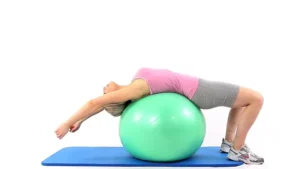
Thoracic Extension on a Foam Roller
A great exercise for kyphosis is the Thoracic Extension on a Foam Roller because it targets the thoracic spine, or mid-back, which is frequently rounded and inflexible in kyphotic individuals. This exercise helps to cure a rounded back by extending and mobilizing the upper spine, improving posture, and restoring mobility in the thoracic area.
- Start utilizing yourself on the floor with your knees bent.
- A foam roller should be positioned horizontally behind you, perpendicular to your spine.
- Place the foam roller under your mid-back and slowly lie back on it.
- To keep yourself stable, keep your knees and hips bent.
- Put both hands behind your head.
- Take a deep breath, then slowly relax your thoracic spine by extending your upper back over the foam roller.
- Focus on expanding the front of the rib cage and opening up the chest as you gradually arch over the roller.
- As you carefully and slowly walk back to the starting position, release your breath.
- To target different areas of the thoracic spine, you can move the foam roller slightly up and down along your upper and mid-back.
- Then return to your neutral position.
- Then relax.
- Repeat these exercises 5 to 10 times.
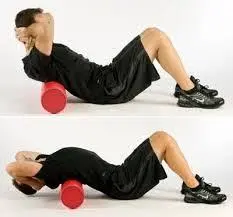
Thoracic Extension Using Chair
The Extension of the Thorax To help reverse the rounded posture linked to kyphosis, chair exercises are an excellent method to target and activate the thoracic spine, or upper back. This exercise promotes spine extension, which may help with posture and chest opening.
- In a comfortable chair, sit up straight and bend your knees.
- Put your hands behind your head with your elbows bent out to the sides.
- Throughout the exercise, use your core to prevent putting too much strain on your lower back.
- To get ready, take a big breath.
- By stretching your thoracic spine over the back of the chair, slowly lean back.
- Lean back and let your chest slowly arch and expand up.
- Maintain the proper positioning of your head and spine.
- Make an effort to stretch your thoracic spine and open your rib cage.
- Hold this position for a few seconds.
- Then return to your neutral position.
- Then relax.
- Repeat these exercises 5 to 10 times.
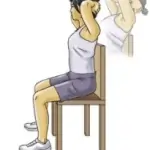
What precautions should be followed when exercising?
Exercise for kyphosis, particularly postural or moderate structural kyphosis, requires careful attention to detail to avoid injury and achieve the best possible results. A useful list of safety measures is as follows:
Get an Expert Evaluation
- Find out the kind and severity of your kyphosis from a physician or physical therapist before beginning.
- Depending on whether your kyphosis is structural (from Scheuermann’s illness or another condition) or flexible (postural), they can create a customized workout regimen.
Refrain from heavy lifting or high impact.
- Exercises involving high impact (such as jumping), heavy overhead lifting, or significant back bending (hyperextension) should be avoided without supervision.
Make Slow Progress
- Begin with modest intensity and low resistance.
- Only make gradual progress if you can keep your posture straight during the entire action.
Pay Attention to Correct Form
- Always put proper technique ahead of weight or repetition count.
- During activity, bad posture can worsen kyphosis or result in new injuries.
Pay Attention to the Spine Position
- Any workout that puts your spine in too much flexion should be avoided, such as heavy rowing without form control or deep crunches.
- Always try to maintain a neutral spine, which is neither excessively rounded nor overly arched.
Build Up the Correct Muscles
- Concentrate on building stronger core and upper back muscles, such as the rhomboids and trapezius.
- Exercise more than just your chest since overdeveloped chest muscles can cause you to slide deeper into kyphosis.
Pay attention to your body.
- If you experience tingling, numbness, or intense pain, stop immediately as these are warning indicators.
- While soreness is common, burning or intense pain is rare.
Stretch the Tight Spots.
- People with kyphosis often have stiff muscles in their front shoulders, hip flexors, and chest.
- Stretching improves posture and range of motion.
Get Warm and Get Cool.
- Before working out, do mild, dynamic movements to warm up your muscles.
- Light stretches should be performed afterward for continued flexibility.
The Key Is Regularity
- It is more secure and effective to make little, consistent gains rather than difficult yourself too soon.
When Should You Quit Working Out?
When dealing with a spinal condition like kyphosis, it’s especially important to know when to stop or adjust your routine. Exercise is essential for managing and preventing kyphosis, but if you do it incorrectly, excessively, or ignore your body’s signals, it may cause more harm than good.
Here is a comprehensive guide on whether to quit exercising or adjust your workout regimen if you have kyphosis:
If You Feel Pain
After an exercise, little muscle soreness is common, but radiating, stabbing, or severe pain is cause for concern.
Quit up or change if you feel:
- Your spine hurts when you move or after.
- Pain radiating down your arms or legs could indicate nerve involvement.
- Pain in the neck or lower back caused by compensatory posture.
- Upper back ache that suddenly gets worse.
If You’re Using Bad Form
Spinal control and posture are frequently impacted by kyphosis. Injury risk plus poor form equals bad results.
Quit if:
- Maintaining a neutral spine is impossible when working out.
- Other muscle groups are being used as a form of compensation.
- In an attempt to “push” posture correction, you’re putting unnecessary stress on your neck or lower back.
If You Experience Weakness, Tingling, or Numbness
These neurological symptoms may be a sign of compression of the spinal nerve.
Signs to look out for:
- Hand or arm tingling or numbness.
- Weakening of the muscles during everyday activities.
- Incapacity to coordinate or a feeling of “deadness.”
If You’re Tired or Overtrained
Fatigue, inflammation, or a decline in spinal health might result from overtraining.
Stop if,
- Serious pain in the muscles that lasts for more than 48 to 72 hours.
- Being fatigued after working out rather than stimulated.
- Performance or postural deterioration with time.
If you’re not improving or if things are getting worse
Even with consistent exercise, if your flexibility, strength, or posture are getting worse, something is wrong.
What to do:
- Reevaluate your program, intensity, or form.
- Consult a physical therapist or rehabilitation professional for advice.
- Think about including corrective workouts or mobility exercises.
If Your Medical Condition Is New or Getting Worse
Exercise may be dangerous if you have inflammation, infections, or other conditions.
Action to take:
- Take a rest and speak with your physician.
- Exercise connected to kyphosis should only be done when your body is prepared.
Prevention of kyphosis:
The goals of kyphosis prevention are to strengthen supporting muscles, maintain a healthy spine, and improve posture. Postural kyphosis and osteoporosis-related kyphosis can frequently be prevented with the right treatments, though not all forms of kyphosis (such as congenital or certain structural types) can be prevented.
Engage in Regular Exercise
Exercise supports healthy spinal position by strengthening your shoulders, core, and back.
- Back extensions: Develop upper back strength.
- Build core stability with planks and side planks.
- Pilates and yoga: Encourage posture, body awareness, and flexibility.
Stretch Frequently
Poor posture can be encouraged by the upper body being pulled forward by tense muscles in the chest and front shoulders.
- Thoracic spine stretch with foam roller
- Doorway stretch
- Cat-Cow stretch
- Neck and shoulder rolls
Keep Your Posture Correct
One of the most frequent causes of kyphosis, particularly among teenagers and office workers, is poor posture.
- Maintain a straight back and relaxed shoulders while sitting up straight.
- Avoid curving your upper back or slouching, especially when you’re sitting for extended periods.
- Make use of an ergonomic chair that supports your spine’s natural curvature.
- Avoid leaning forward by keeping screens at eye level.
- Do “postural resets” every half an hour to an hour.
Safety of Backpacks and Bags
One of the main causes of students’ postural kyphosis is heavy backpacks.
- Select backpacks with broad, cushioned straps.
- No more than 10–15% of your body weight should be carried.
- Don’t simply wear one shoulder strap; wear both.
- For improved support, use bags with waist or chest straps.
Ergonomic Modifications for Work and Home
It is essential to create an environment that is spine-friendly.
- Make use of lumbar-supporting chairs.
- It is best to position screens at eye level or slightly below.
- If at all possible, switch up your posture by using standing workstations.
Frequent examinations and early detection
If identified early, many forms of structural kyphosis, such as Scheuermann’s disease, can be treated or improved, particularly in teenagers.
- Persistent soreness in the back.
- Variations in posture or height.
- Difficulties breathing or moving about.
Summary:
A spinal disorder called kyphosis is defined by an excessive outward curving of the thoracic spine, giving the impression of a rounded or stooped back.
Kyphosis can frequently be successfully treated by doctors using a variety of nonsurgical techniques. Treatment may not be necessary for mild curves that don’t cause any other symptoms. Additional choices include bracing, physical therapy, and dealing with underlying conditions including osteoporosis.
One of the best ways to treat kyphosis is by exercise, particularly when it’s in its early or postural stages. The secret is regularity. These exercises can improve posture, lessen pain, and increase quality of life when performed regularly. Always be mindful of your body and achieve gradual but consistent progress.
FAQ:
Which workouts are beneficial for kyphosis?
The best workouts concentrate on:
Increasing the strength of the posterior shoulder, core, and upper back muscles.
Training for balance and posture awareness
Can kyphosis be reversed by exercise?
Particularly for postural kyphosis, which is prevalent in young individuals, exercise can help with posture and lessen the symptoms of kyphosis. Exercise may not completely cure spinal curvature in situations with structural kyphosis (such as Scheuermann’s disease), but it can help control pain and improve function.
How frequently should I perform exercises for kyphosis?
Try to perform this three to five times a week for the most effective outcomes.
Incorporate moderate stretches and daily posture checks.
Short, frequent workouts are better than lengthy, frequent ones; consistency is essential.
Can kyphosis be helped by yoga or pilates?
Yes! Being conscious of the body Yoga movements like Child’s Pose, and Cat-Cow are especially helpful.
Should I refrain from doing specific exercises?
Straining activities or heavy overhead lifts that aggravate posture.
Excessive flexion of the spine (such as crunches), particularly in cases of pain or severe curvature. A healthcare professional should always be consulted before beginning a new regimen.
When should I schedule a visit with a physician or physical therapist?
Consult a specialist if you have:
Pain in the back that is ongoing or getting worse
Having trouble with everyday tasks
Curvature that is severe or getting worse
neurological symptoms, such as tingling and numbness
How long does it take to see results?
Consistent effort may show improvements in pain and posture after 4–8 weeks. Longer-term structural modifications might require a mix of medical intervention, bracing, or treatment.
What signs of kyphosis are present?
Upper back hunch or round
Stiffness or pain in the back
Feeling tired
Reduced range of motion
In extreme situations: trouble breathing or nerve problems
Is it possible to avoid kyphosis?
Although it is impossible to prevent every type, the risk can be decreased by:
Keeping proper posture
Developing core and back strength
Maintaining an active lifestyle
Getting enough vitamin D and calcium
Preventing children and teenagers from carrying heavy backpacks
Does kyphosis cause pain?
It might be. Pain varies in intensity and cause. While structural kyphosis can result in persistent pain, particularly if nerves are involved, postural kyphosis can cause muscle tiredness.
References:
- Samarpan Physio 2023: The Top 7 Exercises for Kyphosis – Physiotherapist, Physiotherapist
- Surrey Physio’s Top 5 Strategies for Reducing Kyphosis
- Exercises for kyphosis to address a rounded upper back (2023) Freutel
- What is kyphosis? Kandola in 2023
- Chiropractor in Wyoming, Minnesota: The Top 10 At-Home Exercises for Overcoming Kyphosis
- Kyphosis – 2025
- Kyphosis: Signs, Activities, and Therapy – 2024 – Physio
- The top 10 exercises for kyphosis to address rounded upper backs
- Image 9, The Top 10 Stability Ball Workouts for the Whole Body in 2022 by Bob and Brad

